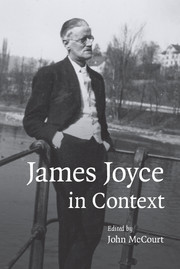Book contents
- Frontmatter
- Contents
- Notes on contributors
- Preface
- List of abbreviations
- PART I LIFE AND WORKS
- PART II THEORY AND CRITICAL RECEPTION
- PART III HISTORICAL AND CULTURAL CONTEXTS
- 14 Being in Joyce's world
- 15 Dublin
- 16 Nineteenth-century lyric nationalism
- 17 The Irish Revival
- 18 The English literary tradition
- 19 Paris
- 20 Trieste
- 21 Greek and Roman themes
- 22 Medicine
- 23 Modernisms
- 24 Music
- 25 Irish and European politics: nationalism, socialism, empire
- 26 Newspapers and popular culture
- 27 Language and languages
- 28 Philosophy
- 29 Religion
- 30 Science
- 31 Cinema
- 32 Sex
- Further reading
- Index
14 - Being in Joyce's world
Published online by Cambridge University Press: 14 July 2009
- Frontmatter
- Contents
- Notes on contributors
- Preface
- List of abbreviations
- PART I LIFE AND WORKS
- PART II THEORY AND CRITICAL RECEPTION
- PART III HISTORICAL AND CULTURAL CONTEXTS
- 14 Being in Joyce's world
- 15 Dublin
- 16 Nineteenth-century lyric nationalism
- 17 The Irish Revival
- 18 The English literary tradition
- 19 Paris
- 20 Trieste
- 21 Greek and Roman themes
- 22 Medicine
- 23 Modernisms
- 24 Music
- 25 Irish and European politics: nationalism, socialism, empire
- 26 Newspapers and popular culture
- 27 Language and languages
- 28 Philosophy
- 29 Religion
- 30 Science
- 31 Cinema
- 32 Sex
- Further reading
- Index
Summary
We are always moving further from the material world that Joyce and his characters inhabited. Even when we exclude Joyce's travels and limit our definition of that world to early twentieth-century Dublin, and even when we are equipped with copious information about the history, politics, religion, economics and sociology of Joyce's era, the fictions themselves often bring us up short, forcing us to attend to how Dubliners coped – smoothly or inexpertly, unreflectively or thoughtfully – with the environment that situated and shaped their way of being. Joyce's thinking about human activity began from quasi-Aristotelian premises about a generic relation to a generic world. From these premises, Joyce arrived at some of the positions occupied by his coeval, Martin Heidegger, who had also revisited Aristotle in order to rethink the philosophical tradition. In particular, Heidegger's attention to Being-in-the-World – to situated human beings – can help us to understand Joyce's descriptions of this or that Dubliner's ordinary activities. Invoking the phenomenological tradition is not to deny that Joyce was fascinated by his early reading of Aristotelian philosophy, which sharply separates perceiving subject from observed object. However, this primary attention to an individual's visual experience was challenged by his awareness that a given individual necessarily engaged with and was reciprocally constituted by a specific historical world.
The context that we call everyday life has been a principal object of study for historians, anthropologists and sociologists from the beginnings of their disciplines.
- Type
- Chapter
- Information
- James Joyce in Context , pp. 163 - 172Publisher: Cambridge University PressPrint publication year: 2009
- 1
- Cited by



